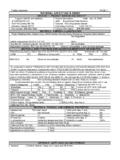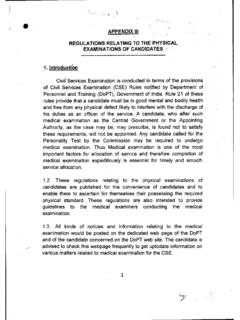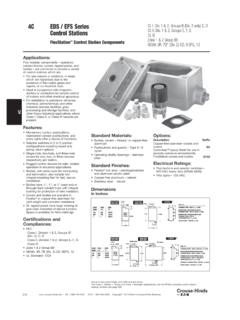Transcription of ter Edcatio oewor orsheet Chapter Reviews / Page 1
1 Chapter review Exercises Chapter Reviews / Page 1. Hunter Education Homework Worksheet Name_____. Date of Birth _____ Course Date _____. Chapter 1: Introduction to Hunter Education 2. Label the four indicated parts of a bolt-action rifle: i. _____ ii. _____. 1. In addition to teaching safety, a primary objective of hunter education programs is to_____. a. give every hunter the same degree of skill or knowledge b. ensure that everyone enjoys hunting and has an opportunity to hunt c. produce knowledgeable, responsible, and involved hunters d. none of the above. iii. _____ iv. _____. 2. Name three hunting-related projects for which the Federal Aid in Wildlife Restoration Act (Pittman-Robertson Act) provides funding: 3.
2 You should only use ammunition that exactly matches the caliber or i. _____ gauge specifications marked on the _____of your firearm. ii. _____. iii. _____ 4. Label the indicated parts of rifle and shotgun ammunition. 3. Which of these is not a source of hunter education funding? i. _____. a. State highway departments b. State wildlife agencies ii. _____. c. International Hunter Education Association d. Fish & Wildlife Service iii. _____. 4. Name three behaviors of a responsible hunter. i. _____ iv. _____ shotshell ii. _____. iii. _____ cartridge 5. List six types of firearms actions: i. _____. Chapter 2: Be a Responsible and Ethical Hunter ii. _____. 1. _____ are passed to help conserve wildlife for future genera- iii.
3 _____. tions to enjoy. iv. _____. v. _____. 2. Hunting laws protect _____ and _____, vi. _____. and ensure _____ and _____, and help the _____. 6. A safety is a device that ensures a firearm can never be accidentally fired. a. True 3. Aldo Leopold, the father of wildlife management, defined ethical b. False behavior as: doing the right thing when no one else is _____. even when doing the wrong thing is _____. 7. The most accurate sight for a firearm is the _____. 4. List 4 things that responsible, ethical hunters should respect: 8. Steel shot is: i. _____ a. Lighter than lead shot, reducing its velocity and distance ii. _____ b. Harder than lead shot, keeping the pattern tighter iii.
4 _____ c. Non-toxic, unlike lead shot that can be toxic to waterfowl iv. _____ d. All of the above. 5. Studies have shown that as a hunter gains experience and skill he or 9. Different gauge shotshells should not be mixed together because _____. she will typically pass through five distinct stages of development. a. Once mixed, it is impossible to separate them accurately The stage in which success is measured by the total experience and an b. A smaller gauge shotshell can slip past the chamber of a larger gauge appreciation of wildlife, outdoors, and companions is known as the gun and result in serious personal injury _____ stage. c. A 12-gauge shotshell can be chambered into a 20-gauge shotgun and result in serious personal injury d.
5 None of the above. Chapter 3: Know Your Firearm Equipment 10. Knowing your firearm's range is critical. It allows you to: 1. The three basic parts of a modern firearm are _____. a. Determine whether or not you're able to make a clean kill a. Cartridge, stock, and barrel b. Make accurate shots at any distance as long as they are within your b. Action, stock, and barrel firearm's range c. Stock, trigger, and action c. Know at what distances your firearm could cause injury d. Barrel, chamber, and muzzle d. Both a and c. Copyright 2015 Kalkomey Enterprises, Inc., Chapter Reviews / Page 2. 11. Firearms must be stored _____, in a _____ 11. Name the four main causes of hunting incidents. location, and separate from ammunition.
6 I. _____. ii. _____. iii. _____. Chapter 4: Basic Shooting Skills iv. _____. 1. Good marksmanship is _____. 12. If three hunters are walking in single file, it is acceptable for the hunter a. Being able to hit your target at least 50% of the time in the center to use the _____. b. Correctly marking your target a. Cradle carry c. Being a good sport if you miss your target b. Elbow or side carry d. Hitting your target accurately and consistently c. Shoulder carry 2. To help you steady the rifle when you're ready to shoot, draw a deep d. Trail carry breath and _____. 13. To check for obstructions: 3. The proper technique for pulling the trigger when shooting a rifle is to i. Point the _____ in a safe direction.
7 _____. ii. Open the _____ and _____ the firearm. a. Pull the trigger quickly, moving only your finger iii. Check for debris in the _____. b. Squeeze the trigger slowly iv. Remove any obstruction with a _____, and then c. Jerk the trigger _____ the barrel. d. Snap the trigger 14. If crossing a fence while hunting alone, you should _____. 4. Of the four shooting positions, the steadiest is the _____ position. a. cross the fence with the gun held under your arm a. Sitting b. place the gun on the other side of the fence with the muzzle pointed b. Kneeling away from you, and then cross c. Standing c. set the gun down, cross, and then pull the muzzle to you d. Prone d. any of the above 5.
8 For large slow game, such as turkey, use a _____ or 15. To load or unload a firearm safely, you should always _____. _____choke. a. put the safety on. b. dry fire the firearm before loading and after unloading. 6. A common error when hunting with a shotgun is _____. c. point the muzzle in a safe direction. a. Tapping the trigger and not squeezing it slowly d. both a and c. b. Bringing the stock all the way up to the cheek without lowering the head 16. To transport a firearm safely, always _____ the firearm, c. Lowering the head and cheek to the stock of the shotgun open the _____, and put the firearm in a_____. d. Failing to align the sights on the target properly and then take a 17.
9 Hunters should be spaced _____ yards apart, and each deep breath should have a zone of fire of _____ degrees in front. 7. Which shotgun shooting technique is best for a beginning hunter and 18. If you take prescription medication, you should ask your physician if is performed by pointing at a moving target, and then moving past it it's safe to take while hunting. and firing? a. True a. Snap shooting b. False b. Swing-through c. Sustained lead d. Patterning Chapter 5: Using Stands, Boats, and ATVs 8. All handguns should be fired at _____ length. 1. _____ should be worn at all times while climbing a tree and when on a tree stand. 9. To minimize the risk of a firearm incident in the home, you should a.
10 Climbing boots never _____. b. Thick outerwear a. Point a muzzle in a safe direction c. A fall-arrest system b. Keep your finger off the trigger when handling the firearm d. Camouflage outerwear c. Store the firearm and ammunition together d. Check that the chamber and magazine are empty 2. To get your firearm into an elevated stand safely: a. climb into the stand using the cradle carry 10. List the four primary rules of firearm safety. b. climb into the stand and have your companion carefully toss your i. _____. firearm up to you _____. c. climb into the stand using the sling carry ii. _____. d. haul up the unloaded firearm after you have secured yourself in the _____. stand. iii. _____.






